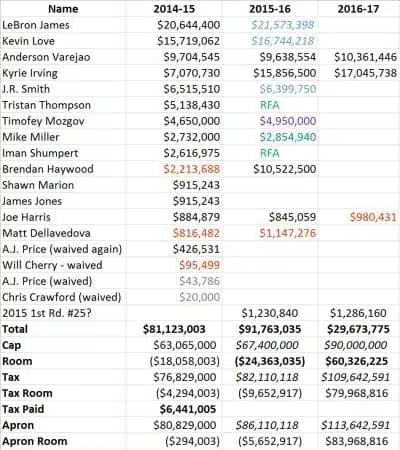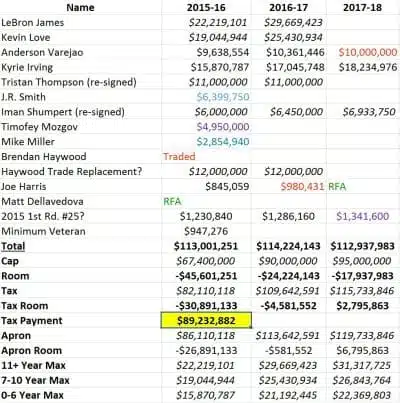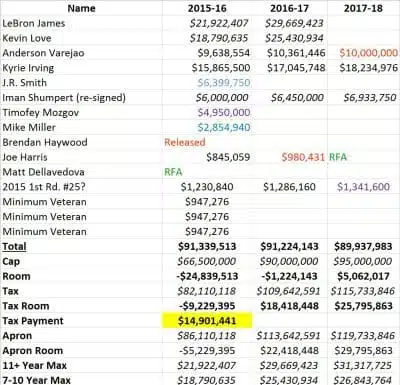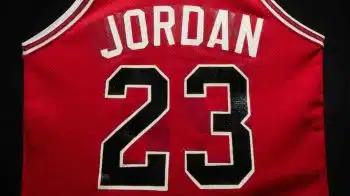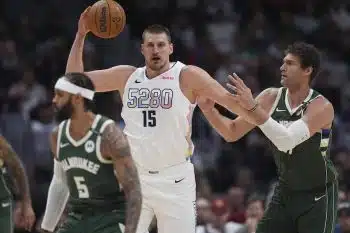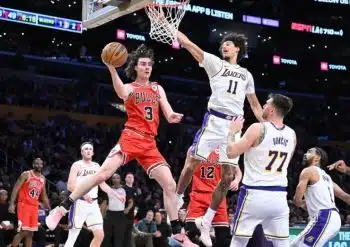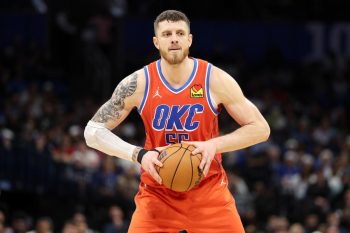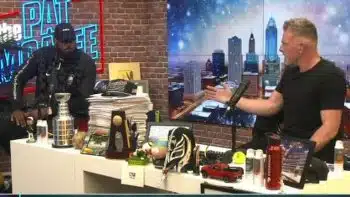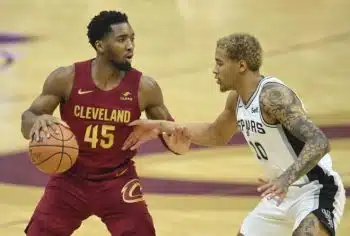NBA
Cleveland Had To Deal, But It Will Cost Dan Gilbert
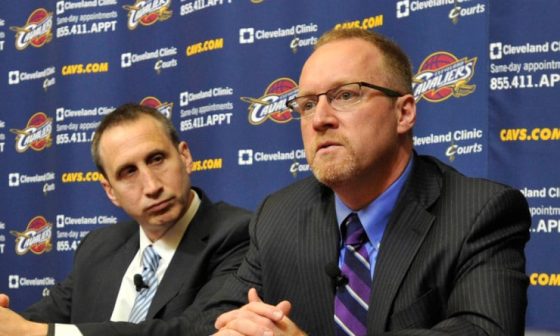
Shortly after the Cleveland Cavaliers extended Anderson Varejao in October, I looked at how the Cavaliers got to this point and concluded that it would be difficult to add to the team without swallowing a large tax bill. With the recent acquisitions of Timofey Mozgov, Iman Shumpert and J.R. Smith for far less outgoing salary, the Cavs have doubled down.
ESPN’s Brian Windhorst did a nice job detailing the cap machinations that enabled these acquisitions. The Cavaliers used the trade exception they got from trading Keith Bogans to the Boston Celtics to acquire Mozgov. Per Windhorst, the Cavs’ justification for exchanging the non-guaranteed Bogans for a trade exception rather than keeping him was that they didn’t want to pay him for this year and that they were worried they would potentially have to guarantee his salary by the January guarantee date if they could not move him. For reasons I explained back in November, giving up Bogans cost the Cavs’ flexibility, and also came at the cost of two second-round picks.
So what does the Cavs’ financial future look like now that they have Mozgov, Smith and Shumpert in the fold? If Cleveland is going to truly maximize its competitive potential and keep LeBron James happy over the next few years (perhaps not one and the same), Dan Gilbert better start practicing his check-writing skills.
Here is the Cavaliers’ current salary structure:
We can make a few assumptions about Cleveland’s future. First, we will assume Kevin Love remains, as the Cavs’ planning is focused entirely around that. Love and James will both likely opt out of their contracts this summer for the reasons noted back in November.
Given the amount the cap is projected to rise in 2016, Love and James may each sign similar contracts to LeBron’s most recent deal – two years with a second-year player option. This will allow them to become free agents again in 2016, when their individual maximums should be about $30 million and $25 million respectively if the cap rises to $90 million with no smoothing.
The four key variables are Smith, Shumpert, Tristan Thompson and the non-guaranteed $10.5 million contract of Brendan Haywood. Smith will probably opt into his $6.4 million player option for next season, as it seems unlikely he will get that much per season on the open market. That is by no means assured at this point though, since he will be nearly 30 and may determine that a longer-term deal for less annual value would maximize his total earnings. Cleveland may also bribe him with a longer contract for less money per season if he is willing to opt out in an effort to shift more of his cost onto later years when its tax concerns will be lessened. In another scenario, Smith could shoot the lights out this year and merit a higher annual value, which would also be a reason to opt out. Nevertheless, the assumption for now will be that he opts in – it is certainly the one the New York Knicks made when trading him to free up cap space for this summer.
Shumpert can be a restricted free agent in the summer. In theory he fits the archetype of the 3-and-D player who has become so valuable league-wide, having shown some modicum of capability at both those skills at various times in his career. Overall though, it must be remembered that he has never exceeded this year’s 12.1 PER, and only once exceeded the league average from downtown. The Oak Park River-Forest High School product* has only periodically impressed defensive metrics. He fared well in advanced plus-minus metrics in 2013-14, but less so this year. He is a fringe starter, though young enough at 24 to improve. But it should also be noted that the capped-out Cavs will have no way to replace him this offseason. Assuming he plays reasonably well, a three-year deal starting at $6 million per season seems about right.
Thompson has played about as well as could be expected this year, and units with he and Love had done well until Varejao’s injury. Nevertheless, he is and probably always will be a center in a power forward’s body. That means Thompson is probably best as a third big man, which he presumably will be with Mozgov on board. What’s more, he is a restricted free agent, which will allow the Cavaliers to match any offer. It is hard to imagine any other team breaking the bank for Thompson when he probably is not a starting-caliber big all things considered.*
Working in Thompson’s favor, of course, is the fact that he is repped by Klutch Sports, an agency with which James is heavily involved. Moreover, like with Shumpert, Cleveland will have no way to replace him if they let him go – presumably they will have learned by now that Varejao cannot be counted on to last an entire season. Much of Thompson’s eventual salary would seem to depend on James’ influence and how the Cavs will finish the season, which are difficult to project right now. A fair price for Thompson would probably be around $7 or $8 million a season as a quality third big. But James’ influence and the Cavs’ inability to replace him could push that much higher. At the outer bound, let’s call that a contract starting at $11 million per season.
Finally, the Haywood contract. Many have lauded the Cavaliers for acquiring him over the summer from the Charlotte Hornets because he provides a way for Cleveland to add salary this summer even if they are capped out. They trade him for a matching salaried player, and the other team gets cap relief by waiving him.
But there are two problems with that now that the Mozgov trade has been consummated. First, it would be almost impossible for the Cavs to add another $10 million or more in salary and remain below the Apron, a level $4 million above the tax. A team cannot acquire a player via sign-and-trade if it finishes the transaction above the Apron, so acquiring a free agent with the Haywood contract is almost certainly out.*
Second, to acquire a player with positive value using the Haywood contract, Cleveland will need a sweetener. After trading away Dion Waiters and its protected draft pick from the Memphis Grizzlies for Mozgov, the Cavs are about fresh out. Even their first-rounder this year must be swapped with the Chicago Bulls from the Luol Deng trade, so they cannot count on it being any higher than number 25 or so. Because they owe a 2016 first-rounder to the Boston Celtics as the cost of their efforts to offload salary to sign LeBron James, they have restrictions on trading their own future first-rounders. That pick is top-10 protected through 2018, then becomes unprotected in 2019. The Ted Stepien rule prevents the trading of future picks in two consecutive years. Because the pick could be conveyed in any of 2016 to 2019, Cleveland would have to write the trade as being two years after whenever the Celtics pick is conveyed. That may not be until 2021.
So the only real trade assets the Cavs have are Chicago’s 2015 pick (which could be conveyed after the selection is actually made) and their own pick that may well not be available until 2021. That package seems unlikely to convince a team to give up a truly valuable player making $10 million or so. If the Haywood contract is to be used, it will likely require the acquisition of an overpaid negative asset (albeit one who presumably can still play some). As a taxpayer, Cleveland will be limited to 125% of the salary it sends out in any such trade.*
Nevertheless, suppose Dan Gilbert green-lights the addition of more salary via a trade of the Haywood contract. Cleveland’s cap sheet might look something like this:
Hoo boy.* That’s about $89 million in luxury tax for 2015-16, without considering a possible re-signing of Matthew Dellavedova, signing a player via the $3.4 million taxpayer’s mid-level exception or filling out the roster over 13 players. At that tax level, each additional dollar will cost Gilbert another $4.75 in luxury taxes. Making matters worse, the Cavs almost certainly will not have anything approaching cap room in the summer of 2016 either, assuming James and Love maximize their earning power by signing new contracts again that offseason.
Granted, acquiring more salary with the Haywood contract may not happen. If so, that would cut Cleveland’s luxury tax by more than half.
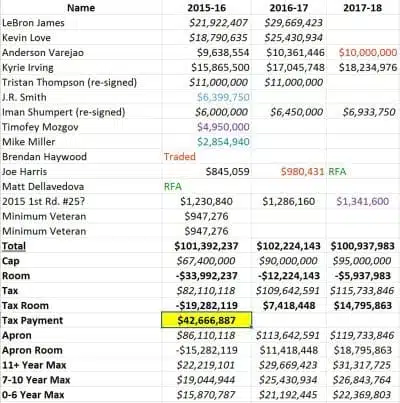
The nature of roster building must make taxpaying extremely difficult to swallow for owners. To acquire a player with the Haywood contract under this scenario, Gilbert would essentially be paying almost $59 million for a player with a $12 million salary. Although perhaps the more accurate way of looking at it is to take the whole cost of the roster and distribute the tax bill pro-rata among their salaries, that view is extremely difficult to stomach when one transaction juices the tax bill by so much.
It would be perfectly understandable if Gilbert does not want to up payroll even further, although whether LeBron James tries to force his hand is another story. Here, however, is where we return to the needless Varejao extension. Cleveland had absolutely no need to act when it did, and as we predicted in November, his contract will indeed be a bitter pill for Gilbert to swallow. After his injury (which was not entirely unpredictable given his history), Cleveland could likely have re-signed Varejao for a few million per season at most this summer. Instead, the Cavs will have to either forego using the Haywood contract to acquire more salary or pay up to $50 million for the privilege.
Now that the die has been cast, what could be the best option for Cleveland going forward? Assuming James doesn’t interfere, moving on from Thompson could be the best option if he is going to cost anywhere near the eight figures he reportedly demanded in extension talks this fall. Shumpert fills a massive need for defense on the wing – one that likely cannot be upgraded since the Cavaliers will have little chance to replace him. It would probably behoove Cleveland to re-sign him as long as the price is not astronomical. Here’s what the cap sheet would look like at that point:
The tax bill is much lower under this scenario, at only $9.2 million over the tax and a $14.9 million tax payment. Unfortunately, the Cavs would then need another competent big, another rotation wing and possibly a backup point guard if restricted free agent Dellavedova either leaves, becomes too expensive or proves this season he’ll be unworthy of the job.
To fill those positions, Cleveland will have:
- The taxpayer’s mid-level exception (MMLE), with which they could offer a three-year deal starting at $3.4 million.
- Their draftee from Chicago’s first-round pick, around number 25.
- The $10.5 million Haywood non-guaranteed contract to trade.
- Minimum salary slots.
At that point, every additional dollar spent would cost $3.25 in tax for dollars $15-20 million, which rises by 50 cents per dollar for each additional $5 million increment (e.g., $3.75 per dollar from $20-25 million).
Is that enough to fill Cleveland’s needs for next year? History has shown the number 25 pick won’t help right away, and a good rotation wing or big would be hit or miss with the MMLE. They could package their draftee with the Haywood contract to fill one or both of those holes, but that again would cost as much as $50 million.
Can the Trade Save Cleveland This Year?
Perhaps more important than the future tax concerns is whether this makes the Cavs better this year. Many have criticized the Cavs for giving up Dion Waiters and perhaps the crown jewel in their arsenal (the Memphis first-round pick) for Mozgov, Shumpert and Smith. Given the circumstances though, it was necessary. The Cavaliers’ entire long-term plan will be torpedoed if Love leaves, and a first-round playoff exit could punt him right out the door as a free agent. Competing this year to make sure he stays is imperative. This deal was by far the best available to do that, especially since Cleveland could not wait until the trade deadline with the season slipping away.
The Cavs were in a spot of desperation, and Denver took advantage of that to get two first-rounders for Mozgov. And one of the tenets of trading is that you never want to get into a position where you have to make a move. But what should the Cavs have done differently, at least as it relates to this season? The Varejao extension was foolish, but it does not kick in until next year. And keeping Bogans instead of trading him for an exception wouldn’t have changed much for this year either.
What’s more, the return has at least the potential to really help Cleveland. Mozgov might be a slightly below-average starting center, but he is a starting center under contract for less than $5 million this year and next. The fact he fit into the Bogans trade exception meant he was one of the few players in the league who the Cavs could acquire. That cheap contract, not just his ability, is part of why his price was so steep. Having him instead of a similar player for $10 million a year will save Gilbert millions in luxury tax payments. What’s more, he replaces essentially the worst third big in the league now that Varejao is out.
Shumpert and Smith have played solid roles on playoff teams in the past, but they are more valuable for who they are replacing than how great they are themselves. Cleveland was giving major minutes on the wing to Joe Harris (7.1 PER), Dellavedova (6.2), Waiters (12.1, awful on catch and shoots, played little D), Shawn Marion (10.8, couldn’t space the floor) and James Jones (14.1 PER, but sub-replacement defense for years). Simply reducing the minutes for those replacement-level players could have an enormous impact if Shumpert and Smith can stay healthy.
Even with a better rotation, the Cavs’ stars will need to play much better on both ends to truly contend. Love and James have each played below their established levels, and even Irving’s overall offensive production could improve. All three stars have also suffered from injuries this year that could be sapping their effectiveness.
Ultimately, Cleveland’s fortunes lie with their stars. But Griffin has at least plugged enough holes in the roster to give them a chance. It is just going to cost Gilbert an astronomical sum.
New York Knicks:
The Knicks have been criticized in some quarters for not getting more for Shumpert, having “merely” dumped Smith’s salary and acquired a 2019 second-rounder. Don’t count me among those critics. Shumpert’s value was never all that high – the best reported offer for him was Oklahoma City’s first-rounder (it is unclear which one) last year. He was more valuable then, when the Knicks had yet to implode and he was under a cheap rookie contract for a further season.
One way to look at the deal is the market price for taking on salary. In past years, the price for taking on salary has been a projected late first-rounder for $10 million in salary.* Smith was owed $6.5 million this year and $6.4 million next year. It can be argued that New York did in fact get about a first-rounder’s worth of value out of Shumpert as the price to offload that amount of salary.
Oklahoma City Thunder:
If Oklahoma City’s goal is to improve the team this year, I am not sure acquiring Waiters helps much. He has been a horrible spotup shooter, and, what’s worse, has been reluctant to embrace that role. He is somewhat redundant with Reggie Jackson, as a slasher but somewhat inefficient scorer on the second unit. Waiters probably doesn’t really even defend shooting guards much better than Jackson, or fit better with Russell Westbrook either. He is under contract for another season on his rookie deal, and could be extended when the cap goes up in 2016 and the Thunder probably would not impact the luxury tax. So it makes more sense financially for 2015-16, and Waiters does have talent that may be realized in Oklahoma City.
The bigger problem with the deal though is the opportunity cost. The Thunder might have filled their biggest need for a true two-way wing with the pick they sent out, perhaps by bringing back Jeff Green, trading for Arron Afflalo, making a bid for Luol Deng or a host of other scenarios. They then could have brought such a player back for next year. While they have been loath to pay the tax, they could have done so for a year to appease Kevin Durant in the final season before his free agency. The Thunder just fired one of their biggest bullets and probably did not make their team much better on the floor this year.
